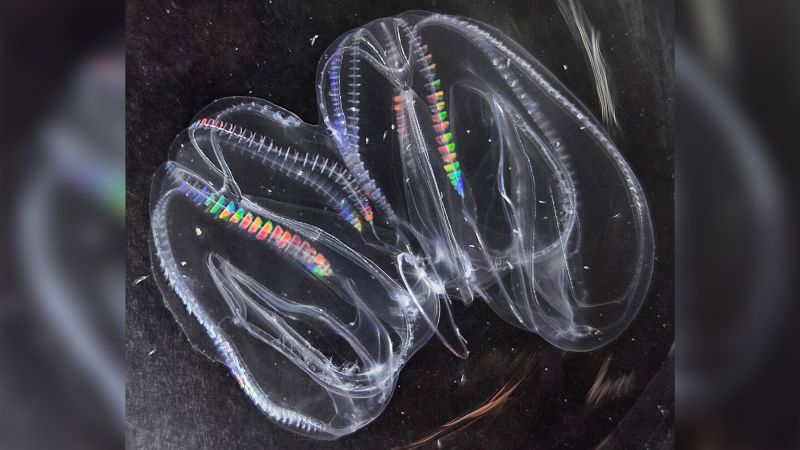In the summer of 2023, an exciting discovery unfolded at the Woods Hole Oceanographic Institution in Massachusetts, as Kei Jokura, a marine biologist, entered the lab carrying an intriguing blob in a beaker. This blob was not just any specimen; it was noticeably larger than the others, and it appeared as though two gelatinous comb jellies, scientifically classified as *Mnemiopsis leidyi*, had fused into a single organism. Joiura, then a postdoctoral researcher at the University of Exeter in the UK, was almost incredulous at that moment, recalling that his initial reaction was one of disbelief.
On this night, Mariana Rodriguez-Santiago, a postdoctoral researcher at Colorado State University, was also working on her separate research project when Jokura approached her with the extraordinary find. They were both filled with wonder and curiosity, asking questions such as, “How can these jellies swim and move as a unit?” Rodriguez-Santiago gently prodded the jellies with a pipette, observing that both parts responded in unison. This extraordinary phenomenon piqued their interest and spurred them on a scientific journey to understand this fusion of life.
In the subsequent weeks, Jokura and Rodriguez-Santiago collaborated closely to experiment with the fusion process, attempting to combine multiple pairs of the comb jellies to uncover the underlying biological mechanisms. Their research, published on October 7, 2023, in *Current Biology*, revealed groundbreaking findings. They discovered that not only did the two jellies merge their physical forms; their nervous and digestive systems integrated as well, highlighting a remarkable instance where two individuals effectively became one organism.
The implications of this discovery are vast, pushing the boundaries of biological understanding. Jokura expressed his intrigue about questions concerning which genes govern fusion, how neural signaling is affected, and what it fundamentally means to define ‘self’ versus ‘nonself.’ He noted that each theme could significantly challenge existing perspectives within biology, opening up new avenues of research.
Belonging to a distinct phylum known as Ctenophora, comb jellies are fascinating creatures often confused with jellyfish despite lacking stinging capabilities and residing in different biological classifications. Ctenophores, which translates to “comb-bearers” in Greek, utilize rows of cilia, resembling hairlike appendages, for propulsion through the water. One vital aspect of their evolutionary history makes them particularly interesting: they are among the oldest surviving animals on Earth, possibly even sharing a close lineage to other animal forms, thus providing scientists unique opportunities to study basic aspects of nervous system function.
Pawel Burkhardt, an evolutionary biologist at the University of Bergen in Norway, pointed out that these ancient animals were present during the initial evolution of multicellular life. His own concurrent study of *M. leidyi* published in *PNAS* investigated how these jelly-like organisms can regress to earlier developmental stages in response to stress, further demonstrating the remarkable adaptability of ctenophores.
The significance of fusing comb jellies also raises questions regarding allorecognition—the biological mechanism that helps organisms discern their own cells from foreign ones. In more complex organisms like humans, allorecognition is critical for preventing organ rejection during transplants, showcasing how the immune system differentiates between self and non-self. Jokura’s findings suggest that ctenophores may lack this mechanism, enabling them to maintain a flexible approach to merging tissues and possibly improving chances of survival.
In an attempt to understand this unique fusion process better, Jokura and Rodriguez-Santiago conducted experiments where they artificially combined the jellies using surgical techniques. Strikingly, their efforts were met with nearly a 90% fusion success rate, resulting in configurations with two sensory organs and two sets of anal openings—unlike their typical single sets.
Timed imaging experiments revealed that the integration of both jellies occurred more rapidly than anticipated, with synchronized muscle contractions manifested within mere hours. They noted that after a couple of hours, activating one half would also prompt a simultaneous reaction in the other half. Observations of the digestion stream further revealed a seamless sharing of food and nutrients, as pieces ingested by one jelly moved into the digestive track of the mate, resulting in simultaneous excretion—an extraordinary example of biological convergence.
Rodriguez-Santiago expressed a profound interest in what these observations imply regarding the ambiguous boundaries once thought to exist between individual organisms. The capacity of these jellies to integrate their systems illustrates a fascinating deviation from standard understandings of body autonomy and biological self-recognition. Burkhardt added that this research may shed light on when such adaptive recognition evolved and help elucidate the complexities of how simple nervous systems operate and process information.
Jokura’s research ultimately invites more extensive exploration into the nature of consciousness itself as it relates to the jellies’ integrated nervous systems in a shared biological context. By examining how “thoughts” intermingle, researchers may one











